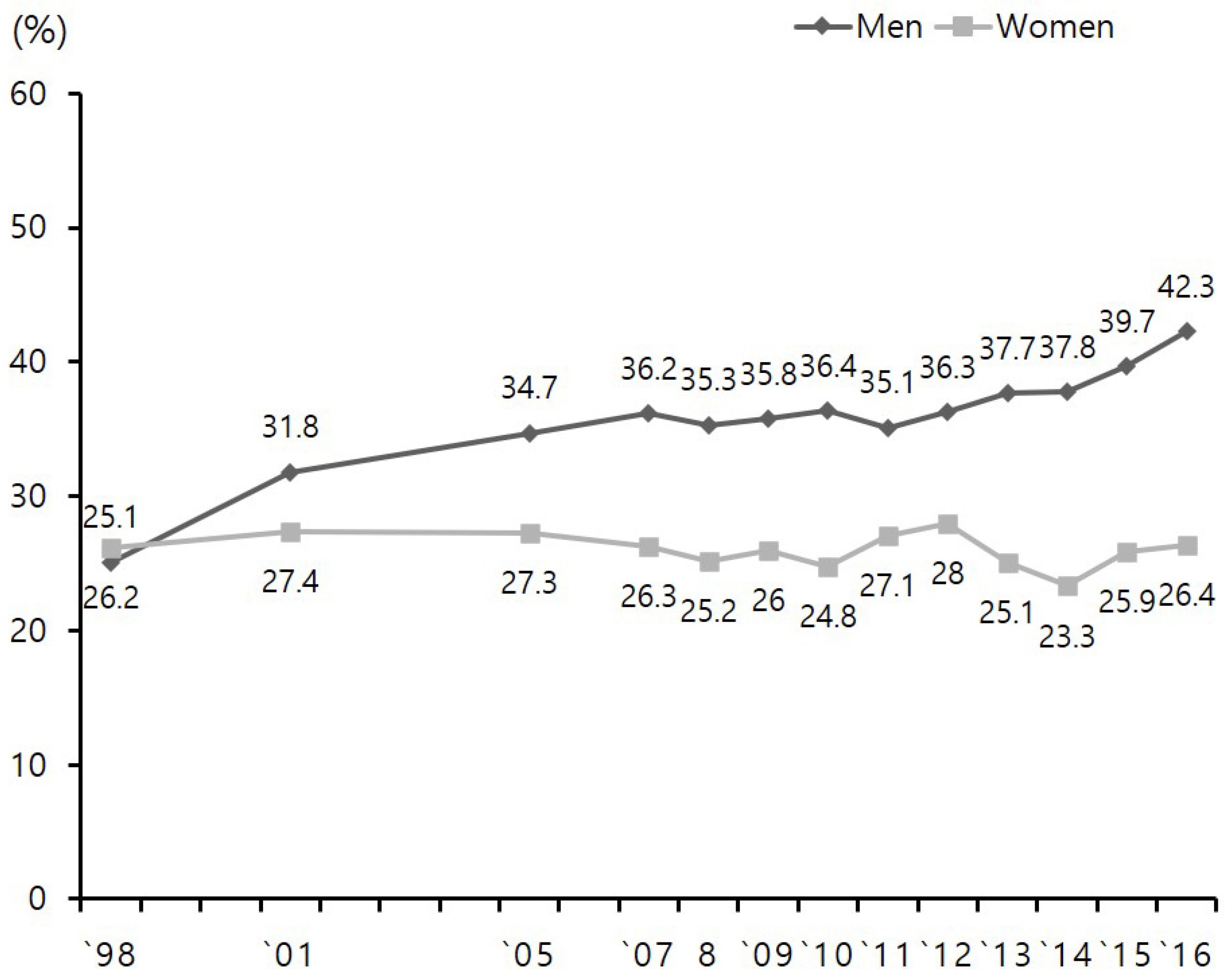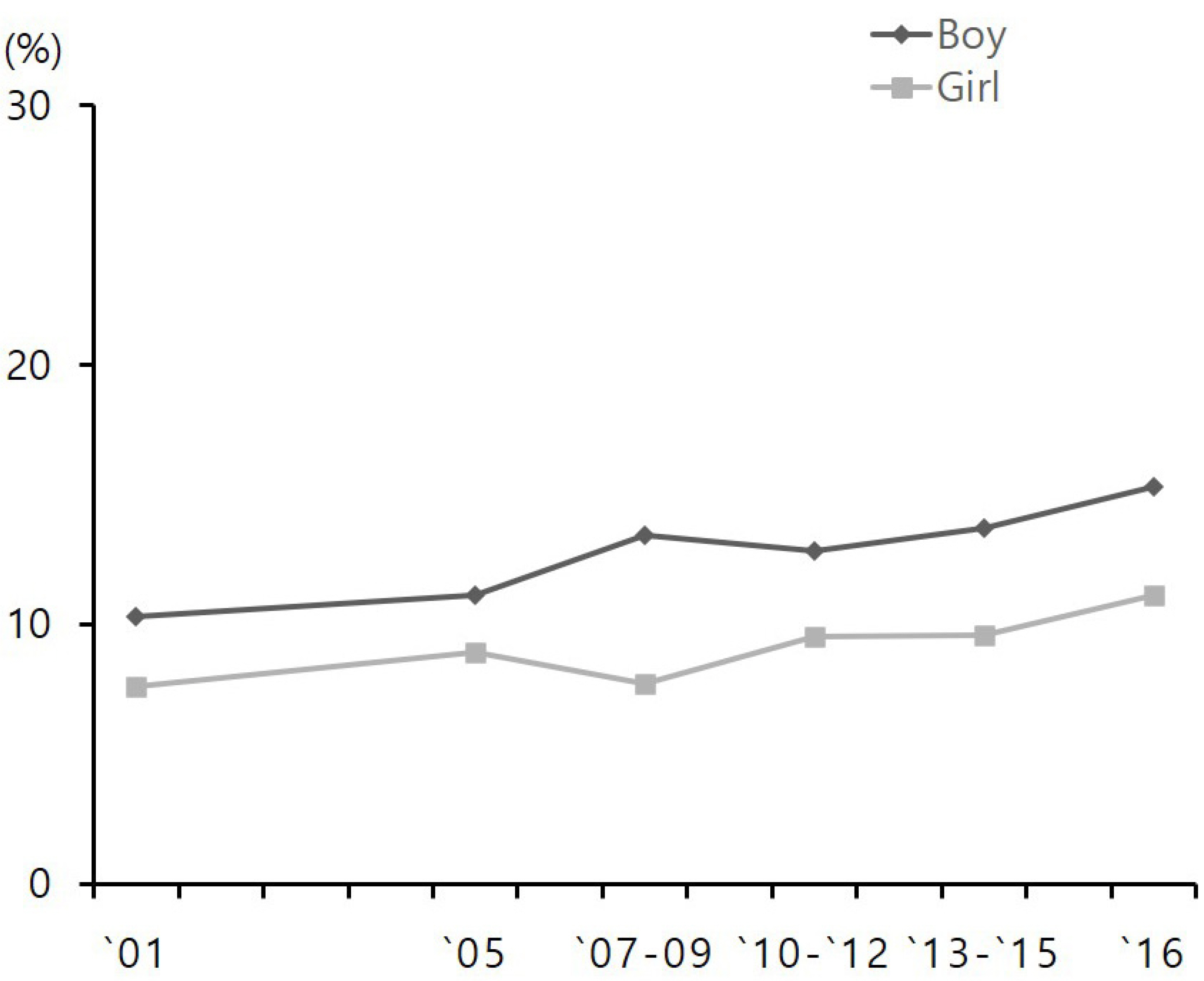Korean J Gastroenterol.
2020 May;75(5):240-245. 10.4166/kjg.2020.75.5.240.
Obesity and Pancreatobiliary Disease
- Affiliations
-
- 1Division of Gastroenterology, Department of Internal Medicine, Hallym University Dongtan Sacred Heart Hospital, Hwaseong, Korea
- KMID: 2504244
- DOI: http://doi.org/10.4166/kjg.2020.75.5.240
Abstract
- Obesity has become a major medical and public health problem worldwide. Recent studies have shown that obesity is a chronic disease that is associated with many diseases, such as gallstone disease, acute pancreatitis, fatty liver, and digestive cancer. Obesity is also a risk factor for the formation of cholesterol gallstones. Clinical and epidemiological studies have suggested that obesity is positively associated with the risk of gallbladder cancer. Obesity may modulate the lipid and endogenous hormones metabolism, affect gallbladder motility, increase the risk of gallstones, and increased the risk of gallbladder cancer. In addition, obesity has been considered a risk factor for pancreatic diseases, including pancreatitis and pancreatic cancer. Obese patients develop systemic and local complications of acute pancreatitis more frequently. Several epidemiologic studies have suggested an association of pancreatic cancer with high body mass and lack of physical activity. This study reviewed the literature on obesity and pancreatobiliary disease in terms of epidemiology and mechanism.
Figure
Reference
-
1. Ogden CL, Yanovski SZ, Carroll MD, Flegal KM. 2007; The epidemiology of obesity. Gastroenterology. 132:2087–2102. DOI: 10.1053/j.gastro.2007.03.052. PMID: 17498505.
Article2. Ng M, Fleming T, Robinson M, et al. 2014; Global, regional, and national prevalence of overweight and obesity in children and adults during 1980-2013: a systematic analysis for the Global Burden of Disease Study 2013. Lancet. 384:766–781. DOI: 10.1016/S0140-6736(14)60460-8. PMID: 24880830. PMCID: PMC4624264.3. Portincasa P, Moschetta A, Palasciano G. 2006; Cholesterol gallstone disease. Lancet. 368:230–239. DOI: 10.1016/S0140-6736(06)69044-2.
Article4. Krishna SG, Hinton A, Oza V, et al. 2015; Morbid obesity is associated with adverse clinical outcomes in acute pancreatitis: a propensity-matched study. Am J Gastroenterol. 110:1608–1619. DOI: 10.1038/ajg.2015.343. PMID: 26482857.
Article5. Cruz-Monserrate Z, Conwell DL, Krishna SG. 2016; The impact of obesity on gallstone disease, acute pancreatitis, and pancreatic cancer. Gastroenterol Clin North Am. 45:625–637. DOI: 10.1016/j.gtc.2016.07.010. PMID: 27837777.
Article6. Dittrick GW, Thompson JS, Campos D, Bremers D, Sudan D. 2005; Gallbladder pathology in morbid obesity. Obes Surg. 15:238–242. DOI: 10.1381/0960892053268273. PMID: 15802067.
Article7. Stender S, Nordestgaard BG, Tybjaerg-Hansen A. 2013; Elevated body mass index as a causal risk factor for symptomatic gallstone disease: a Mendelian randomization study. Hepatology. 58:2133–2141. DOI: 10.1002/hep.26563. PMID: 23775818.
Article8. Stampfer MJ, Maclure KM, Colditz GA, Manson JE, Willett WC. 1992; Risk of symptomatic gallstones in women with severe obesity. Am J Clin Nutr. 55:652–658. DOI: 10.1093/ajcn/55.3.652. PMID: 1550039.
Article9. Tsai CJ, Leitzmann MF, Willett WC, Giovannucci EL. 2004; Prospective study of abdominal adiposity and gallstone disease in US men. Am J Clin Nutr. 80:38–44. DOI: 10.1093/ajcn/80.1.38. PMID: 15213025.
Article10. Freeman JB, Meyer PD, Printen KJ, Mason EE, DenBesten L. 1975; Analysis of gallbladder bile in morbid obesity. Am J Surg. 129:163–166. DOI: 10.1016/0002-9610(75)90292-5.
Article11. Maclure KM, Hayes KC, Colditz GA, Stampfer MJ, Speizer FE, Willett WC. 1989; Weight, diet, and the risk of symptomatic gallstones in middle-aged women. N Engl J Med. 321:563–569. DOI: 10.1056/NEJM198908313210902. PMID: 2761600.
Article12. Portincasa P, Di Ciaula A, Palmieri V, Van Berge-Henegouwen GP, Palasciano G. 1995; Effects of cholestyramine on gallbladder and gastric emptying in obese and lean subjects. Eur J Clin Invest. 25:746–753. DOI: 10.1111/j.1365-2362.1995.tb01953.x. PMID: 8557061.
Article13. Bonfrate L, Wang DQ, Garruti G, Portincasa P. 2014; Obesity and the risk and prognosis of gallstone disease and pancreatitis. Best Pract Res Clin Gastroenterol. 28:623–635. DOI: 10.1016/j.bpg.2014.07.013. PMID: 25194180.
Article14. Shiffman ML, Sugerman HJ, Kellum JM, Moore EW. 1992; Changes in gallbladder bile composition following gallstone formation and weight reduction. Gastroenterology. 103:214–221. DOI: 10.1016/0016-5085(92)91115-K. PMID: 1612328.
Article15. Tsai CJ, Leitzmann MF, Willett WC, Giovannucci EL. 2006; Weight cycling and risk of gallstone disease in men. Arch Intern Med. 166:2369–2374. DOI: 10.1001/archinte.166.21.2369. PMID: 17130391.
Article16. Dietz WH, Robinson TN. 2005; Clinical practice. Overweight children and adolescents. N Engl J Med. 352:2100–2109. DOI: 10.1056/NEJMcp043052. PMID: 15901863.17. Palasciano G, Portincasa P, Vinciguerra V, et al. 1989; Gallstone prevalence and gallbladder volume in children and adolescents: an epidemiological ultrasonographic survey and relationship to body mass index. Am J Gastroenterol. 84:1378–1382. PMID: 2683739.18. Di Ciaula A, Wang DQ, Portincasa P. 2012; Gallbladder and gastric motility in obese newborns, pre-adolescents and adults. J Gastroenterol Hepatol. 27:1298–1305. DOI: 10.1111/j.1440-1746.2012.07149.x. PMID: 22497555.
Article19. Mehta S, Lopez ME, Chumpitazi BP, Mazziotti MV, Brandt ML, Fishman DS. 2012; Clinical characteristics and risk factors for symptomatic pediatric gallbladder disease. Pediatrics. 129:e82–e88. DOI: 10.1542/peds.2011-0579. PMID: 22157135.
Article20. Banks PA, Bollen TL, Dervenis C, et al. 2013; Classification of acute pancreatitis--2012: revision of the Atlanta classification and definitions by international consensus. Gut. 62:102–111. DOI: 10.1136/gutjnl-2012-302779. PMID: 23100216.
Article21. Yashima Y, Isayama H, Tsujino T, et al. 2011; A large volume of visceral adipose tissue leads to severe acute pancreatitis. J Gastroenterol. 46:1213–1218. DOI: 10.1007/s00535-011-0430-x. PMID: 21805069.
Article22. Sadr-Azodi O, Orsini N, Andrén-Sandberg Å, Wolk A. 2013; Abdominal and total adiposity and the risk of acute pancreatitis: a populationbased prospective cohort study. Am J Gastroenterol. 108:133–139. DOI: 10.1038/ajg.2012.381. PMID: 23147519.
Article23. Taguchi M, Kubo T, Yamamoto M, et al. 2014; Body mass index influences the outcome of acute pancreatitis: an analysis based on the Japanese administrative database. Pancreas. 43:863–866. DOI: 10.1097/MPA.0000000000000137. PMID: 24786667.24. Martínez J, Johnson CD, Sánchez-Payá J, de Madaria E, Robles-Díaz G, Pérez-Mateo M. 2006; Obesity is a definitive risk factor of severity and mortality in acute pancreatitis: an updated meta-analysis. Pancreatology. 6:206–209. DOI: 10.1159/000092104. PMID: 16549939.
Article25. Shin KY, Lee WS, Chung DW, et al. 2011; Influence of obesity on the severity and clinical outcome of acute pancreatitis. Gut Liver. 5:335–339. DOI: 10.5009/gnl.2011.5.3.335. PMID: 21927663. PMCID: PMC3166675.
Article26. Frossard JL, Lescuyer P, Pastor CM. 2009; Experimental evidence of obesity as a risk factor for severe acute pancreatitis. World J Gastroenterol. 15:5260–5265. DOI: 10.3748/wjg.15.5260. PMID: 19908332. PMCID: PMC2776851.27. Fain JN, Madan AK, Hiler ML, Cheema P, Bahouth SW. 2004; Comparison of the release of adipokines by adipose tissue, adipose tissue matrix, and adipocytes from visceral and subcutaneous abdominal adipose tissues of obese humans. Endocrinology. 145:2273–2282. DOI: 10.1210/en.2003-1336. PMID: 14726444.
Article28. Noel P, Patel K, Durgampudi C, et al. 2016; Peripancreatic fat necrosis worsens acute pancreatitis independent of pancreatic necrosis via unsaturated fatty acids increased in human pancreatic necrosis collections. Gut. 65:100–111. DOI: 10.1136/gutjnl-2014-308043. PMID: 25500204. PMCID: PMC4869971.
Article29. Panek J, Sztefko K, Drozdz W. 2001; Composition of free fatty acid and triglyceride fractions in human necrotic pancreatic tissue. Med Sci Monit. 7:894–898. PMID: 11535930.30. Khatua B, El-Kurdi B, Singh VP. 2017; Obesity and pancreatitis. Curr Opin Gastroenterol. 33:374–382. DOI: 10.1097/MOG.0000000000000386. PMID: 28719397. PMCID: PMC6640854.
Article31. Patel K, Trivedi RN, Durgampudi C, et al. 2015; Lipolysis of visceral adipocyte triglyceride by pancreatic lipases converts mild acute pancreatitis to severe pancreatitis independent of necrosis and inflammation. Am J Pathol. 185:808–819. DOI: 10.1016/j.ajpath.2014.11.019. PMID: 25579844. PMCID: PMC4348470.
Article32. Navina S, Acharya C, DeLany JP, et al. 2011; Lipotoxicity causes multisystem organ failure and exacerbates acute pancreatitis in obesity. Sci Transl Med. 3:107ra110. DOI: 10.1126/scitranslmed.3002573. PMID: 22049070. PMCID: PMC3321362.
Article33. Renehan AG, Tyson M, Egger M, Heller RF, Zwahlen M. 2008; Body-mass index and incidence of cancer: a systematic review and meta-analysis of prospective observational studies. Lancet. 371:569–578. DOI: 10.1016/S0140-6736(08)60269-X. PMID: 18280327.
Article34. Wolin KY, Carson K, Colditz GA. 2010; Obesity and cancer. Oncologist. 15:556–565. DOI: 10.1634/theoncologist.2009-0285. PMID: 20507889. PMCID: PMC3227989.
Article35. Calle EE, Rodriguez C, Walker-Thurmond K, Thun MJ. 2003; Overweight, obesity, and mortality from cancer in a prospectively studied cohort of U.S. adults. N Engl J Med. 348:1625–1638. DOI: 10.1056/NEJMoa021423. PMID: 12711737.
Article36. Renehan AG, Soerjomataram I, Tyson M, et al. 2010; Incident cancer burden attributable to excess body mass index in 30 European countries. Int J Cancer. 126:692–702. DOI: 10.1002/ijc.24803. PMID: 19645011.
Article37. Jee SH, Yun JE, Park EJ, et al. 2008; Body mass index and cancer risk in Korean men and women. Int J Cancer. 123:1892–1896. DOI: 10.1002/ijc.23719. PMID: 18651571.
Article38. Campbell PT, Newton CC, Kitahara CM, et al. 2017; Body size indicators and risk of gallbladder cancer: pooled analysis of individual-level data from 19 prospective cohort studies. Cancer Epidemiol Biomarkers Prev. 26:597–606. DOI: 10.1158/1055-9965.EPI-16-0796. PMID: 28314823. PMCID: PMC5380577.
Article39. Jeong SU, Lee SK. 2012; Obesity and gallbladder diseases. Korean J Gastroenterol. 59:27–34. DOI: 10.4166/kjg.2012.59.1.27. PMID: 22289951.
Article40. Aune D, Greenwood DC, Chan DS, et al. 2012; Body mass index, abdominal fatness and pancreatic cancer risk: a systematic review and non-linear dose-response meta-analysis of prospective studies. Ann Oncol. 23:843–852.e2. DOI: 10.1093/annonc/mdr398. PMID: 21890910.
Article41. Majumder K, Gupta A, Arora N, Singh PP, Singh S. 2016; Premorbid obesity and mortality in patients with pancreatic cancer: a systematic review and meta-analysis. Clin Gastroenterol Hepatol. 14:355–368. DOI: 10.1016/j.cgh.2015.09.036. PMID: 26460214. PMCID: PMC4919073.
Article42. Li D, Morris JS, Liu J, et al. 2009; Body mass index and risk, age of onset, and survival in patients with pancreatic cancer. JAMA. 301:2553–2562. DOI: 10.1001/jama.2009.886. PMID: 19549972. PMCID: PMC2760963.
Article43. Sandini M, Bernasconi DP, Fior D, et al. 2016; A high visceral adipose tissue-to-skeletal muscle ratio as a determinant of major complications after pancreatoduodenectomy for cancer. Nutrition. 32:1231–1237. DOI: 10.1016/j.nut.2016.04.002. PMID: 27261062.
Article44. House MG, Fong Y, Arnaoutakis DJ, et al. 2008; Preoperative predictors for complications after pancreaticoduodenectomy: impact of BMI and body fat distribution. J Gastrointest Surg. 12:270–278. DOI: 10.1007/s11605-007-0421-7. PMID: 18060467.
Article45. Avgerinos KI, Spyrou N, Mantzoros CS, Dalamaga M. 2019; Obesity and cancer risk: emerging biological mechanisms and perspectives. Metabolism. 92:121–135. DOI: 10.1016/j.metabol.2018.11.001. PMID: 30445141.
Article46. Murphy N, Jenab M, Gunter MJ. 2018; Adiposity and gastrointestinal cancers: epidemiology, mechanisms and future directions. Nat Rev Gastroenterol Hepatol. 15:659–670. DOI: 10.1038/s41575-018-0038-1. PMID: 29970888.
Article
- Full Text Links
- Actions
-
Cited
- CITED
-
- Close
- Share
- Similar articles
-
- Recent Updates of Immunoglobulin G4-related Pancreatobiliary Disease
- Process and Renewal of Pancreatobiliary Cerification System
- Role of Endoscopic Procedures in the Diagnosis of IgG4-Related Pancreatobiliary Disease
- Gut Microbiota and Pancreatobiliary System
- Correspondence to letter to the editor on “Bariatric intervention improves metabolic dysfunction-associated steatohepatitis in patients with obesity: A systematic review and meta-analysis”




